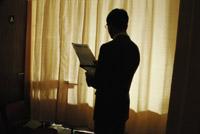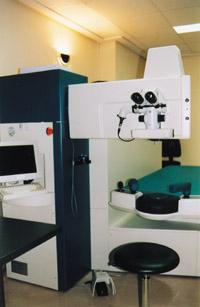Lasik: latest success in eye surgery
Seeing well is not something current. Formerly those who had myopia slept with sandbags in their eyes. The pressure exerted by sacks altered the inclination of the cornea and the person obtained an adequate provisional vision. Since then, eye surgery has advanced greatly. Now, thanks to the LASIK (Laser Asisted in Situ Keratomileusis) technique, you can remove your glasses or contact lenses at the bottom of the drawer of the bedside table. But let's step by step.

Humanity is surrounded by a thick membrane called sclera, except at the front of the eyeball. It contains the cornea, a curved transparent membrane. Light reaches the pupil through the cornea, which acts similar to the diaphragm of a camera, contracting or extending according to the light intensity received. Behind it is the lens that directs light to the retina. The lens crouches or moves away so that the ray of light pits well in the retina. The retina is a photosensitive tissue located behind the eyeball, where nerves turn light into an electric quinad. The quinadas reach the brain and there the image we see is created. The retina is not the only one responsible for focusing the image well. The cornea and the lens act as a double lens and depending on its inclination the light will focus on one or another point. But by 80% the cornea is responsible for seeing the focused image.
Behind the perfect view
As explained in the table “Refractive defects”, the focus of light in people with visual problems does not occur in the retina, so images are blurred. The main solutions to this problem are the use of glasses or contact lenses, the first not mentioned in the article, and surgical correction of the eye. This type of surgery was added the term refractive, since the origin of visual problems is the improper refraction of light. The operation consists of modifying the inclination of the cornea to change the light focus. The
first trials were conducted in 1953 by a Japanese doctor named Sato. From these works, Russian doctors developed in the 1970s the technique known as Radial Keratotomy (RK). The surgeon makes deep radial "V" incisions (up to 90% of the corneal thickness). This reduces the inclination of the cornea and therefore corrects the focus of light. This technique only allows to correct myopia and not any degree of myopia, only light myopia. The results of the operation were unpredictable and highly variable. In addition, due to the incisions made, the tension of the cornea decreases and over time there may be deformations of the inclination of the cornea. The other major drawback of the technique is the long and painful process of eye formation.

The real revolution came with the laser. In the 1980s, American doctors adapted the laser developed by IBM for computer purposes and began using it for eye surgery. Technical name: Photorefractive keratectomy (PRK). Although the base is the same, the tilt change of the cornea is very different. The surgeon leaves the ladder and uses a computer-directed cold laser beam. Laser radiation involves the removal of the epithelium, a protective layer of the cornea, and the chiselling of the cornea surface. This technique, unlike Radial Keratotomy, allows to correct intense myopia, farsightedness and astigmatism.
The laser allows to chisel the skin of the cornea with great precision, which reduces the trauma of the eye. Now, the loss of corneal thickness ranges from 5% to 30% (approximately 3 human hairs) and the tension of the cornea remains constant. After a few days the epithelium occurs again, but the cornea keeps the shape operated.
Photorefractive keratectomy was a major breakthrough in eye surgery, but it contained a major detour: by removing the epithelium, the laser also destroyed the underlying Bowman membrane and after the intervention a membrane formed that hindered vision in the eyes of some patients.
The first operation of Keratomileusis –keratos (cornea) and smileusis (cincelar) was carried out in 1949 by the Colombian physician José Ignacio Barraquer, within his work on lamellar keratectomy. At the beginning of the intervention a part of the surface of the cornea was extracted, frozen, given a new shape, thawed and resewn. To carry out the extraction, Dr. Barraquer devised a very fine mouth tool called microceratomo. After 40 years of use and development of this technique, and taking advantage of technological advances, the Colombian doctor Luis Ruiz created an automatic microceratomo much more precise than the previous one. These two Colombian researchers were the pioneers of the LASIK technique. LASIK, like Photorefractive Keratectomy, uses laser to chisel the cornea, but does not evaporate the epithelium. Through microceratome the epithelium is lifted and the laser is applied directly to the cornea. This allows the Bowman membrane not to be destroyed and after the intervention no layer is formed in the patient's eyes.
LASIK step by step
The LASIK technique, started in 1991, is the most used in refractive surgery. It has spread to everyone. The intervention consists of two main parts: first rises a circle of 0.16 mm thick and 8 mm diameter on the surface of the cornea, using the automatic microceratome. Then the stroma, part of the cornea that is visible, is laser cut. The laser is directed by computer and in each shot extracts from the cornea a layer of 0.25 micrometers thick. The computer has preprogrammed the necessary corrections so that the stroma is cemented with mathematical precision. Finally, the raised corneal part will be placed back in place and since the fabrics tend to stick spontaneously, no seam will be necessary.
The procedure lasts between 10 and 15 minutes and the patient will move home on foot and without any bandage in the eyes. The only anesthesia is the eye drops and during the procedure the patient's eye remains open by means of a tool. At the same time, the patient should look at a parallel red dot. But despite the sudden movements, the computer will follow the movements and the laser will only extract the area to cinelar. Laser work is a few seconds; most of the intervention time is used in eye preparation. Therefore, there is no need to be afraid of not being able to keep the eye still.
LASIK corrects myopia, farsightedness and astigmatism. The dyoptric intervals corrected by LASIK are myopia between 0.5 and 13, hyperopia between 0.5 and 6 and astigmatism between 0.5 and 4.

In the case of myopia, a lens extraction is performed in the central part of the cornea to flatten the cornea and delay the light focus to the retina. In the case of farsightedness, annular extraction is performed on the outside of the cornea to increase the inclination and advance the light focus to the retina. For astigmatism, a cylindrical extraction is performed in the center of the cornea to make the elliptical cornea twisted spherically. If desired, myopia and farsightedness can also be corrected in the same procedure.
The LASIK technique is fully automatic. The microceratomo automatically cuts the corneal surface and the laser is also controlled by computer. This greatly reduces the risks of human errors. But one of the biggest advantages of LASIK is patient comfort. It does not require hospitalization, it is not painful and, as already mentioned, only lasts about 15 minutes. Post-operative recovery is also very fast. Despite having blurred vision and resentment in the first hours, normally and depending on the diopters to correct, in 24 or 48 hours the vision recovers completely. In the same period of time the patient can start their daily activities, including driving. Antibiotics are taken after the procedure for a week. During the first few days or weeks, in addition to discarding sport and especially swimming, the patient will be able to make his usual life. In return, you may forget your glasses or contact lenses.
But LASIK does not look. The laser corrects myopia, farsightedness and/or astigmatism but not presbyopia. The presbyter appears in people older than 40 years as a result of the natural evolution of the eye. The lens loses the flexibility of its youth and decreases its ability to bend and flatten. As a result, light will not focus well on the retina and nearby objects will be seen blurred by older people. Therefore, both to correct myopia by laser, reading and other similar activities, people over 40 years of age will need glasses. As for presbyopia, myopias are a special case. Nearsightedness somehow balances presbyopia and often short-sightedness, even if it is presbyopia, sees very close objects well. When myopia is corrected by LASIK, this balance breaks and the patient may have an impression that worsens nearby vision. Therefore, it is sometimes good not to make a total correction and maintain the advantage of balance, even if the distant view is not perfect.
Not all people are eligible for LASIK treatment, there are a number of requirements to meet: Be over 20 years old, have a healthy cornea and have a stabilized refractive defect. Also, people with eye disease, diabetes or autoimmune diseases are not LASIK suitable for intervention.
LASIK is also an operation
Although laser operation is a very safe technique, it has the same risks as any other intervention. Although the possibilities are very small, during the intervention problems can arise that can damage the vision, such as infections. Even after the operation is over. LASIK treatment affects night vision, for example. In the first few weeks after the intervention it is very common to see a kind of flash or halo around objects, as well as moments of double blindness or vision. Problems usually appear at night and decrease over time, usually after 6 months completely disappear.

At night the pupil expands to receive more light and be able to see it in the dark. At night, most of the cornea participates in the light approach. The problems mentioned above are due to the sculpted and non-chiselled aspects in the eyes of the operatives focusing light on different points. These can be especially annoying in people with very high pupillary dilation. Thus, some people may have vision problems after laser treatment in nighttime or low-light driving situations, such as rain, snow or fog.
Some patients see worse at night than by day after such treatment. The reason is the same: dilation of the pupil. During the day we use a small portion of cornea to see it and most of the light rays received will pass straight into the pupil. Conclusion: the residual refraction that can remain during the day (for safety, the diopters are not completely removed; something is always left, as the diopter 0.25-0.5) is not noticeable in the patient. At night we use a larger piece of cornea to see it and this residual refraction will be noticed by the patient. These problems are very common and can be solved with a second operation or with glasses of night use.
The LASIK technique is the most used and successful technique currently in eye surgery, with very satisfactory results in most cases. However, it is an operation, so do not forget that it also has risks. Ophthalmologists have a long and short 10-year experience in the management of this technique. Sufficient to achieve a high degree of operational specialization, but insufficient to predict long-term problems that the laser can cause in vision.
What does the patient say about LASIK?
Ophthalmologist Jaime Aranberri has provided us with some information about LASIK. But we have also turned to those who have received the treatment, since it is they who have put their eyes under the laser beam. Here we have gathered the experience of two people, information that does not serve to make any statistics, but that will be quite interesting for anyone who wants to receive a laser treatment. Our friends are a man over 40 and a woman. The first almost forgot the operation, since two years have passed since then. The second, on the other hand, perfectly recalls those moments, since just two months ago he passed through the operating room.
Both have highly valued the treatment by recovering almost 100% of vision. The LASIK treatment prevents the need for glasses for daily life, except for reading for age reasons or, rather, pressure.
José Javier operated in San Juan de Luz and has no bad memory "I operated both eyes at once and the operation was very short and simple. I felt no pain and then formed very quickly. After a few days I worked forever, with the only difference that I didn't need glasses." José Javier had a rather large myopia and now only has 0.5 in one eye and 0.75 in the other. "The ophthalmologist told me that they did it intentionally, because if we passed with correction it would become farsightedness, which is a great contrast for a myopic."
Esther operated at the Virgen del Pilar Health Center in San Sebastian and, according to him, "the operation was very simple. The doctor told me at all times what he was doing. The worst were the first hours after the operation. I felt resentment and itching in my eyes and couldn't smell the light." Now, however, you are extremely pleased with the results obtained: Myopia of 0.5 diopters in one eye. It would not go back when we say that the long-term effects of laser treatments are totally unknown. "During these years the technique has experienced great improvements and I don't think it will have problems." José Javier has been without any visual problems for two years.
As for night visibility problems or in poorly lit places, none of them have had problems. In the first few weeks, in addition to having a greater sensitivity to light, no side effects have been detected. "They explained to me that there were those consequences, but at least I haven't noticed anything strange," says Esther. José Javier has also told us the same thing, although "depending on the brightness there are times that I have to wear glasses".
Both were more motivated than the needs for laser treatment. But the technique is expensive: It cost José Javier two years ago 17,000 pounds the operation of both eyes (340,000 pesetas). approx. ), Estherri 500,000 sts. two months ago. But both believe it was worth it. The quality of life of both has improved, even in small things.
Excimer laser operation
The Excimer laser is a laser device used in both LASIK and PRK treatments. Like other laser devices, it also has a tube full of gas mixture. The mixture is composed of argon and fluoride. Although normally these two elements do not form molecules, if they are excited with adequate energy, they form a temporary molecule of ArF, called "excited dimer" or "excimer".
The excimer ArF emits an ultraviolet wavelength radiation of 193 nm when it returns to the basic situation. The laser turns radiation into a beam and uses it to chisel the cornea of the eye. When the ray reaches the cornea, it breaks the bonds between its molecules and extracts a microscopic part of the cornea. The process is called photoextraction. The beam of this wavelength is entirely appropriate for use in refractive surgery, since the photoextraction process does not generate heat. This allows no combustion and minimal damage to eye tissues. The Excimer laser is cold laser type. This
cold is not the intrinsic property of the laser, but the cornea's response to photoextraction.
Buletina
Bidali zure helbide elektronikoa eta jaso asteroko buletina zure sarrera-ontzian











